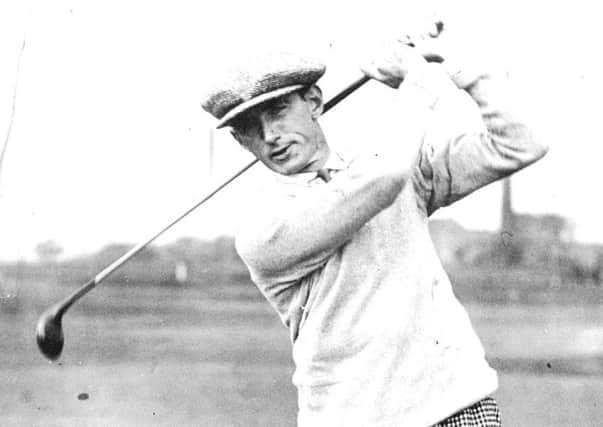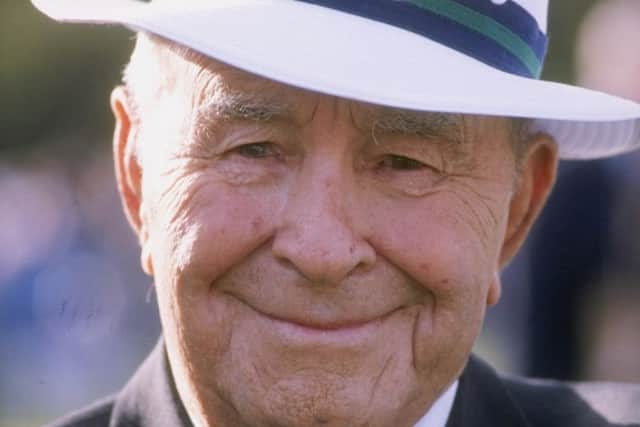Tommy Armour: the Scotsman who won the US PGA


He did so 85 years ago by defeating one of the sport’s all-time greats, Gene Sarazen, at Fresh Meadows, in Queens, New York, when the format was matchplay, which continued until 1958.
Armour remains one of only two Scots golfers to have won the tournament, the other being Jock Hutchison, originally from St Andrews, who won in 1920 at Flossmoor, Illinois.
Advertisement
Hide AdAdvertisement
Hide AdColin Montgomerie, playing this week, came close in 1995, losing out in a play-off, while, in 1919, Fred McLeod, Armour himself in 1935 and Jimmy Thomson a year later were all Scots-born runners-up.


The year after his PGA success, Armour won the Open at Carnoustie, his third Major, his first being the US Open in 1927. He remains the only Scot to have won three of the game’s four Majors.
Arguably, he was unfortunate not to have clinched all four, with the Masters having begun in 1934 when he was, perhaps, no longer at his peak. While it is correct to acknowledge that by the time of his Majors successes he was an American citizen, there is no doubt his golfing ability was forged here, specifically in Edinburgh.
Born in 1896 in Balcarres Street, Morningside, he began playing at the nearby Braid Hills as a youngster along with his elder brother, Sandy, an accomplished golfer who would later win the Scottish amateur title.
A third brother, William, became a professional at Aix les Bains, in southern France, where his pupils included the Aga Khan. Armour later recalled how, as a youngster, “we were on the Braid Hills all the time. In summer I would be on the first tee at 5am and in the evening would play a couple of rounds”.
It was at Braid Hills as a member of the Western club there that he met and formed a lifelong friendship with Bobby Cruickshank, who followed Armour to the States where he also had a very successful career.
However, the First World War nearly put paid to Armour’s golfing career before it had properly begun. While a major in the tank corps, his tank was struck by a shell causing him serious injuries to his left arm and head. Later he was the victim of a mustard gas attack which initially blinded him. In hospital for months, a metal plate was inserted in his head and gradually the sight in his right eye alone was restored.
By 1919, he began to make his mark in the golf world, being runner-up in the Irish amateur and in 1920 won the French amateur. By this time he was a member of the now-defunct Lothianburn club where he played off +2.
Advertisement
Hide AdAdvertisement
Hide AdAfter his French success, he went to the States to play in a number of tournaments. While there, much to the surprise of friends at home, he married Consuelo Carreras, a woman of Cuban descent and the widow of a wealthy Mexican.
No one was more surprised than Marie Young, a violin teacher living in Leith Walk. She claimed Armour had promised to marry her and sued him for £2,000 in the Court of Session for breach of promise. Although he contested it, a jury found in her favour, awarding her £300 in damages. At this time, he was living at Comiston Road and was described as a commercial traveller for the North British Rubber Company in Edinburgh.
He then spent some years flitting back and forth across the Atlantic until 1924 when he settled in the USA, turning professional shortly after and becoming an American citizen.
He achieved the unique distinction of representing Great Britain and the USA in matches against the other. In 1921 at Hoylake he played for a British team against an American amateur team in the forerunner to what was to become the Walker Cup while in 1926 he represented USA at Wentworth in the forerunner to the Ryder Cup.
He enjoyed a hugely successful career in America, winning many tournaments as well as the three Majors. Famous golf wrter Herbert Warren Wind described him as “singularly unaffected by the pressure of the last stretch. His hands were hot but his head cool”. Sarazen who lost the USPGA to him, said: “He made himself into a magnificent professional. Some of his other distinctions are that he says more words per round than any other golfer and is the slowest player in the entire world.”
Armour became an icon of the American golf scene, his prematurely grey hair earning him the soubriquet of “the silver Scot”. After his tournament career finished he became a celebrated teacher, earning a fortune as “the world’s most expensive teacher”.
The good life became second nature to him, mixing with Hollywood celebrities and teaching high-profile pupils. He was often photographed under his parasol in the mornings at the Boca Raton club, in Florida, dispensing wisdom to pupils with a gin and tonic always in reach before going out in the afternoon to play matches for money.
Armour was a strong-minded individual never afraid to voice his opinions. The affable Cruickshank described him as “the kindest, best-hearted fellow you ever saw” while others were less charitable, considering him “dour and temperamental”. The Lothianburn club history notes. with a certain economy of expression, that when he returned there to meet old contemporaries the visit “did not generate a great level of warmth”.
Irrespective, he was truly a “great” of Scottish and world golf and a Scottish win this week would be a fitting tribute to his great win 85 years ago.